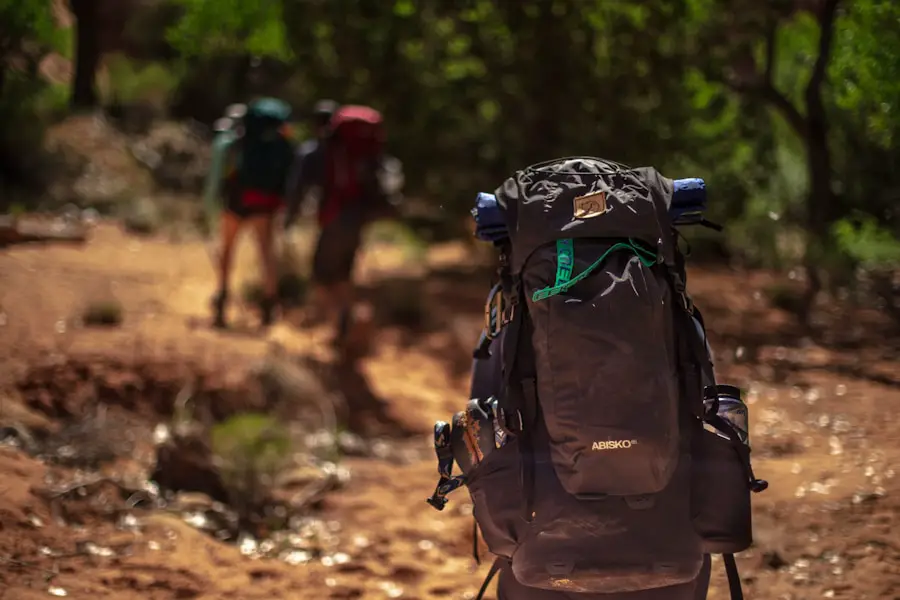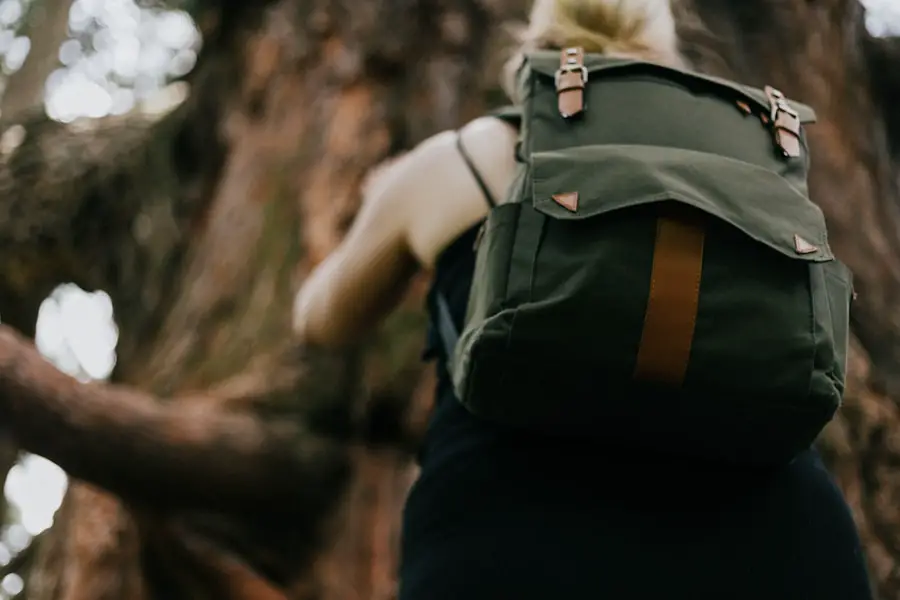Before embarking on the journey of selecting the perfect backpack for your hiking adventures, it is essential to first understand your specific hiking needs. The type of hiking you plan to undertake significantly influences the kind of backpack that will best serve you. For instance, day hikes typically require a smaller, more streamlined pack that can comfortably carry essentials like water, snacks, and a first-aid kit.
Conversely, if you are planning a multi-day trek, you will need a larger backpack that can accommodate additional gear such as sleeping bags, cooking equipment, and extra clothing. Moreover, the terrain and climate of your hiking destination should also be taken into account. If you are hiking in a wet environment, you may want to consider a backpack with waterproof features or a rain cover.
On the other hand, if your hike involves steep ascents or rugged trails, a pack with a more stable fit and better weight distribution will be crucial. Understanding these factors will help you narrow down your options and ensure that your backpack meets the demands of your specific hiking adventures.
Key Takeaways
- Understand your hiking needs before choosing a backpack
- Find the right fit for your body type and hiking style
- Consider capacity and features based on the length and type of your hikes
- Evaluate comfort and support to ensure a comfortable experience
- Explore material and durability to find a long-lasting backpack
Finding the Right Fit
Measuring for the Perfect Fit
A well-fitting backpack is essential for comfort and efficiency on the trail. To determine the right size, start by measuring your torso length, which is typically done by measuring from the base of your neck to the top of your hip bones. Most manufacturers provide sizing charts that correlate torso length with specific backpack sizes, allowing you to select a pack that aligns with your measurements.
Comfortable Hip Belt and Shoulder Straps
In addition to torso length, pay attention to the hip belt and shoulder straps. The hip belt should sit comfortably on your hips, distributing weight evenly and reducing strain on your shoulders. Many backpacks come with adjustable straps to accommodate different body shapes and sizes.
Testing the Backpack
When trying on a backpack, load it with weight similar to what you would carry on a hike and walk around for a few minutes. This will give you a better sense of how the pack feels when in use and whether it provides the necessary support for your body type.
Considering Capacity and Features

The capacity of a backpack is measured in liters and indicates how much gear it can hold. When selecting a backpack, consider not only the duration of your hike but also the type of gear you plan to carry. For day hikes, a pack with a capacity of 20 to 30 liters is often sufficient, while weekend trips may require 40 to 60 liters.
Longer expeditions may necessitate packs that exceed 70 liters. In addition to capacity, consider the features that will enhance your hiking experience. Look for compartments that allow for organized storage of items such as hydration reservoirs, trekking poles, or sleeping bags.
Some backpacks come equipped with external pockets for easy access to frequently used items like snacks or maps. Additionally, features such as ventilation systems can help keep you cool during strenuous hikes, while adjustable straps can provide a customized fit for different loads.
Evaluating Comfort and Support
| Product | Comfort Rating | Support Rating |
|---|---|---|
| Pillow A | 4.5 | 4.2 |
| Pillow B | 4.8 | 4.5 |
| Mattress A | 4.7 | 4.3 |
| Mattress B | 4.9 | 4.7 |
Comfort is paramount when it comes to selecting a hiking backpack, as an uncomfortable pack can lead to fatigue and discomfort on the trail. When evaluating comfort, consider the padding on the shoulder straps and hip belt. High-quality backpacks often feature contoured padding that conforms to your body shape, providing support without causing pressure points.
Additionally, look for backpacks with adjustable suspension systems that allow you to fine-tune the fit based on your body type and load. Support is equally important, particularly for longer hikes where you may be carrying heavier loads. A well-designed frame can help distribute weight evenly across your back and hips, reducing strain on any one area.
Internal frames are common in modern hiking backpacks as they provide stability while maintaining a lightweight design. Some packs also feature load-lifter straps that pull the weight closer to your body, enhancing balance and control while navigating uneven terrain.
Exploring Material and Durability
The materials used in constructing a hiking backpack play a significant role in its durability and performance. Look for packs made from high-denier nylon or polyester fabrics, which are known for their strength and resistance to abrasions. Additionally, consider whether the material has been treated with water-resistant coatings or features such as sealed seams to enhance its ability to withstand wet conditions.
Durability is not just about the fabric; it also encompasses zippers, buckles, and stitching quality. Heavy-duty zippers that can withstand frequent use are essential for ensuring that your gear remains secure during hikes. Reinforced stitching at stress points can prevent seams from tearing under pressure.
Investing in a well-constructed backpack made from quality materials will ensure that it stands up to the rigors of outdoor adventures over time.
Assessing Weight and Size

Weight is another critical factor when selecting a hiking backpack. While it may be tempting to choose a larger pack for its capacity, keep in mind that heavier backpacks can lead to fatigue over long distances. Lightweight options are available that do not compromise on features or durability but allow for easier maneuverability on the trail.
When assessing weight, consider both the empty weight of the pack and how much gear you plan to carry. Size also plays an important role in how well a backpack performs during hikes. A pack that is too large may lead to unnecessary bulk and instability, while one that is too small may not accommodate all your gear comfortably.
Striking a balance between weight and size is essential for optimizing your hiking experience. Many manufacturers offer lightweight models designed specifically for minimalist hikers who prioritize speed and efficiency without sacrificing essential features.
Budgeting for Quality
When it comes to purchasing a hiking backpack, budgeting for quality is crucial. While it may be tempting to opt for cheaper options, investing in a high-quality backpack can significantly enhance your hiking experience and longevity of use. Quality backpacks often come with better materials, superior construction, and thoughtful design features that contribute to overall comfort and performance on the trail.
Consider setting a budget range based on how often you plan to hike and the types of trips you intend to undertake. For occasional day hikers, mid-range options may suffice; however, if you are an avid hiker or plan on undertaking challenging multi-day treks, allocating more funds toward a premium pack can be worthwhile. Additionally, keep an eye out for sales or discounts from reputable outdoor retailers, as this can provide opportunities to acquire high-quality gear at more accessible prices.
Seeking Recommendations and Reviews
Finally, seeking recommendations and reading reviews can provide valuable insights into which backpacks perform well in real-world conditions. Engaging with fellow hikers through forums or social media groups can yield personal experiences that highlight specific models’ strengths and weaknesses. Many outdoor enthusiasts are eager to share their insights based on firsthand experience, which can help guide your decision-making process.
Online reviews from reputable outdoor gear websites can also offer detailed assessments of various backpacks based on performance metrics such as comfort, durability, and functionality. Look for reviews that include user feedback from different types of hikes—this will give you a broader perspective on how well a particular pack performs across various conditions. By combining personal recommendations with expert reviews, you can make an informed choice that aligns with your hiking needs and preferences.
If you are planning a hiking trip and need to choose the right backpack, you may also be interested in reading about the best time to travel to Tanzania. Tanzania is a popular destination for hiking and safaris, so knowing when to visit can make a big difference in your experience. Check out this article for a complete guide on the best time to travel to Tanzania:
